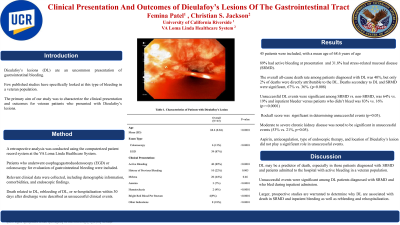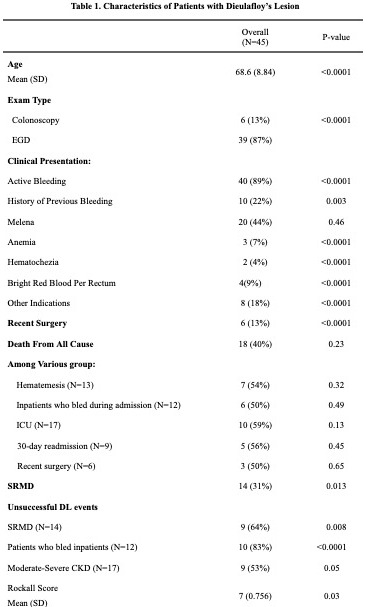Sunday Poster Session
Category: GI Bleeding
P0597 - Clinical Presentation and Outcomes for Dieulafoy’s Lesions of the Gastrointestinal Tract
Sunday, October 22, 2023
3:30 PM - 7:00 PM PT
Location: Exhibit Hall

Has Audio
- FP
Femina Patel, MD
University of California Riverside
San Bernardino, CA
Presenting Author(s)
Femina Patel, MD1, Christian Jackson, MD2
1University of California Riverside, San Bernardino, CA; 2VA Loma Linda Healthcare System, Loma Linda, CA
Introduction: Dieulafoy’s lesions (DL) are an uncommon presentation of gastrointestinal bleeding. Few published studies have specifically looked at this type of bleeding in a veteran population. The primary aim of our study was to characterize the clinical presentation and outcomes for veteran patients who presented with Dieulafoy’s lesions.
Methods: A retrospective analysis was conducted using the computerized patient record system at the VA Loma Linda Healthcare System. Patients who underwent esophagogastroduodenoscopy (EGD) or colonoscopy for evaluation of gastrointestinal bleeding were included. Relevant clinical data were collected, including demographic information, comorbidities, and endoscopic findings. Death related to DL, rebleeding of DL, or re-hospitalization within 30 days after discharge were described as unsuccessful clinical events.
Results: Forty-five patients were included, with a mean age of 68.6 (SD=8.84). Of these, 89% had active bleeding at presentation(p=< 0.0001), and 31.8% had stress-related mucosal disease (SRMD) (p=0.013). The overall all-cause death rate among patients diagnosed with DL was 40%, but only 2% of deaths were directly attributable to the DL. Deaths secondary to DL and SRMD were significant, 67% vs. 36% (p=0.008). Death rate among different groups are listed in Table 1. Unsuccessful DL events were significant among SRMD (SRMD vs. non-SRMD, was 64% vs. 19%, p=0.008), and patients who bled during inpatient admission (inpatient bleeder versus patients who didn’t bleed was 83% vs. 16% p< 0.0001). Rockall score was also noted to be significant in determining unsuccessful events (p=0.03). Finally, moderate to severe chronic kidney disease was noted to be significant in unsuccessful events (53% vs. 21%, p=0.05). Aspirin, anticoagulation, type of endoscopic therapy, and location of Dieulafoy’s lesion were not significant in unsuccessful events.
Discussion: Dieulafoy’s lesions may be a predictor of death, especially in those patients diagnosed with SRMD and patients admitted to the hospital with active bleeding in a veteran population. Unsuccessful events were significant among DL patients diagnosed with SRMD and who bled during inpatient admission. Larger, prospective studies are warranted to determine why Dieulafoy’s lesions are associated with death in SRMD and inpatient bleeding as well as rebleeding and rehospitalization.

Disclosures:
Femina Patel, MD1, Christian Jackson, MD2. P0597 - Clinical Presentation and Outcomes for Dieulafoy’s Lesions of the Gastrointestinal Tract, ACG 2023 Annual Scientific Meeting Abstracts. Vancouver, BC, Canada: American College of Gastroenterology.
1University of California Riverside, San Bernardino, CA; 2VA Loma Linda Healthcare System, Loma Linda, CA
Introduction: Dieulafoy’s lesions (DL) are an uncommon presentation of gastrointestinal bleeding. Few published studies have specifically looked at this type of bleeding in a veteran population. The primary aim of our study was to characterize the clinical presentation and outcomes for veteran patients who presented with Dieulafoy’s lesions.
Methods: A retrospective analysis was conducted using the computerized patient record system at the VA Loma Linda Healthcare System. Patients who underwent esophagogastroduodenoscopy (EGD) or colonoscopy for evaluation of gastrointestinal bleeding were included. Relevant clinical data were collected, including demographic information, comorbidities, and endoscopic findings. Death related to DL, rebleeding of DL, or re-hospitalization within 30 days after discharge were described as unsuccessful clinical events.
Results: Forty-five patients were included, with a mean age of 68.6 (SD=8.84). Of these, 89% had active bleeding at presentation(p=< 0.0001), and 31.8% had stress-related mucosal disease (SRMD) (p=0.013). The overall all-cause death rate among patients diagnosed with DL was 40%, but only 2% of deaths were directly attributable to the DL. Deaths secondary to DL and SRMD were significant, 67% vs. 36% (p=0.008). Death rate among different groups are listed in Table 1. Unsuccessful DL events were significant among SRMD (SRMD vs. non-SRMD, was 64% vs. 19%, p=0.008), and patients who bled during inpatient admission (inpatient bleeder versus patients who didn’t bleed was 83% vs. 16% p< 0.0001). Rockall score was also noted to be significant in determining unsuccessful events (p=0.03). Finally, moderate to severe chronic kidney disease was noted to be significant in unsuccessful events (53% vs. 21%, p=0.05). Aspirin, anticoagulation, type of endoscopic therapy, and location of Dieulafoy’s lesion were not significant in unsuccessful events.
Discussion: Dieulafoy’s lesions may be a predictor of death, especially in those patients diagnosed with SRMD and patients admitted to the hospital with active bleeding in a veteran population. Unsuccessful events were significant among DL patients diagnosed with SRMD and who bled during inpatient admission. Larger, prospective studies are warranted to determine why Dieulafoy’s lesions are associated with death in SRMD and inpatient bleeding as well as rebleeding and rehospitalization.

Figure: A. Characteristics Of Patient With Dieulafoy's Lesion.
Disclosures:
Femina Patel indicated no relevant financial relationships.
Christian Jackson indicated no relevant financial relationships.
Femina Patel, MD1, Christian Jackson, MD2. P0597 - Clinical Presentation and Outcomes for Dieulafoy’s Lesions of the Gastrointestinal Tract, ACG 2023 Annual Scientific Meeting Abstracts. Vancouver, BC, Canada: American College of Gastroenterology.
